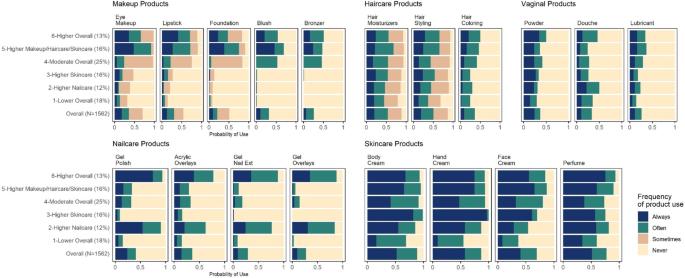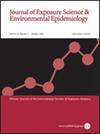育龄黑人使用个人护理产品的频率以及与社会人口特征的关系。
IF 4.7
3区 医学
Q2 ENVIRONMENTAL SCIENCES
Journal of Exposure Science and Environmental Epidemiology
Pub Date : 2024-05-29
DOI:10.1038/s41370-024-00690-x
引用次数: 0
摘要
背景:与白人妇女相比,美国黑人妇女更有可能使用干扰内分泌的化学物质(EDCs)浓度更高、化学配方更苛刻的个人护理产品(PCPs)。这可能会导致黑人妇女出现不同的健康后果,如乳腺癌、心脏代谢后果、不良生育后果和子宫肌瘤的风险增加:对多种类型产品使用五氯苯酚的不同模式进行分类,并研究不同社会人口特征对使用模式的影响:环境、生活方式和子宫肌瘤研究是一项针对居住在密歇根州底特律附近的育龄黑人的队列研究。利用 2013-2018 年间收集的有关五氯苯酚使用频率的自我报告数据,我们采用了潜类分析法来识别具有相似五氯苯酚使用情况的不同参与者群体。我们还比较了不同潜类的社会人口特征:在 1562 名参与者中,我们确定了 6 个潜在类别:总体水平较低;美甲水平较高;护肤水平较高;总体水平适中;化妆/美发/护肤水平较高;总体水平较高。化妆和美甲的使用量最能预测参与者的组别划分。较少使用所有 PCPs 的班级和仅大量使用美甲产品的班级的参与者更有可能报告社会经济地位(SES)较低、目前是吸烟者、体重指数≥35 kg/m2、生育次数≥3 次。相比之下,使用初级保健医生的频率一般且更频繁的班级的参与者更有可能报告较高的社会经济地位、不吸烟、非一胎生育以及曾经使用过口服避孕药:这项研究是首次对一大批年轻的成年黑人女性使用五氯苯酚的情况进行详细评估的研究之一,研究考虑了多种产品类别,包括化妆品、美发产品、护肤产品、美甲产品和阴道产品。该研究使用潜类分析来捕捉五氯苯酚的复杂使用模式,并识别出使用类似产品的不同人群。虽然潜类是针对本研究人群的,但已确定的与潜类相关的社会人口特征或行为可为类似人群提供有针对性且有影响力的减少接触策略。本文章由计算机程序翻译,如有差异,请以英文原文为准。

Frequency of personal care product use among reproductive-aged Black individuals and associations with socio-demographic characteristics
Compared to White women, Black women in the United States are more likely to use personal care products (PCPs) with higher concentrations of endocrine-disrupting chemicals (EDCs) and harsher chemical formulations. This may contribute to differential health outcomes in Black women such as increased risk of breast cancer, cardiometabolic outcomes, adverse birth outcomes, and uterine fibroids. Classify distinct PCP use patterns across multiple types of products and examine how patterns vary by socio-demographic characteristics. The Study of Environment, Lifestyle and Fibroids is a cohort study of reproductive-aged Black individuals living around Detroit, Michigan. Using self-reported data on frequency of PCP collected between 2013–2018, we employed latent class analysis to identify distinct groups of participants with similar PCP use. Socio-demographic characteristics were compared across latent classes. Among 1562 participants, we identified 6 latent classes: Lower Overall; Higher Nailcare; Higher Skincare; Moderate Overall; Higher Makeup/Haircare/Skincare; Higher Overall. Makeup and nailcare usage were the most predictive for classifying participants into groups. Participants in classes with less frequent use of all PCPs and those with only high use of nailcare products, were more likely to report lower socio-economic status (SES), be current smokers, have a body mass index of ≥35 kg/m2, and have ≥3 births. In comparison, participants in classes with average and more frequent use of PCPs were more likely to report higher SES, be non-smokers, be nulliparous, and have ever used oral contraceptives. This study is one of the first detailed assessments of PCP usage among a large cohort of young adult Black women that considers multiple product categories including makeup, hair, skin, nail, and vaginal products. Latent class analysis was used to capture complex patterns of PCP use and identify distinct groups of individuals with similar product use. Although the latent classes are specific to this study population, the identified socio-demographic characteristics or behaviors associated with latent classes may inform targeted and impactful exposure reduction strategies in similar populations.
求助全文
通过发布文献求助,成功后即可免费获取论文全文。
去求助
来源期刊
CiteScore
8.90
自引率
6.70%
发文量
93
审稿时长
3 months
期刊介绍:
Journal of Exposure Science and Environmental Epidemiology (JESEE) aims to be the premier and authoritative source of information on advances in exposure science for professionals in a wide range of environmental and public health disciplines.
JESEE publishes original peer-reviewed research presenting significant advances in exposure science and exposure analysis, including development and application of the latest technologies for measuring exposures, and innovative computational approaches for translating novel data streams to characterize and predict exposures. The types of papers published in the research section of JESEE are original research articles, translation studies, and correspondence. Reported results should further understanding of the relationship between environmental exposure and human health, describe evaluated novel exposure science tools, or demonstrate potential of exposure science to enable decisions and actions that promote and protect human health.

 求助内容:
求助内容: 应助结果提醒方式:
应助结果提醒方式:


